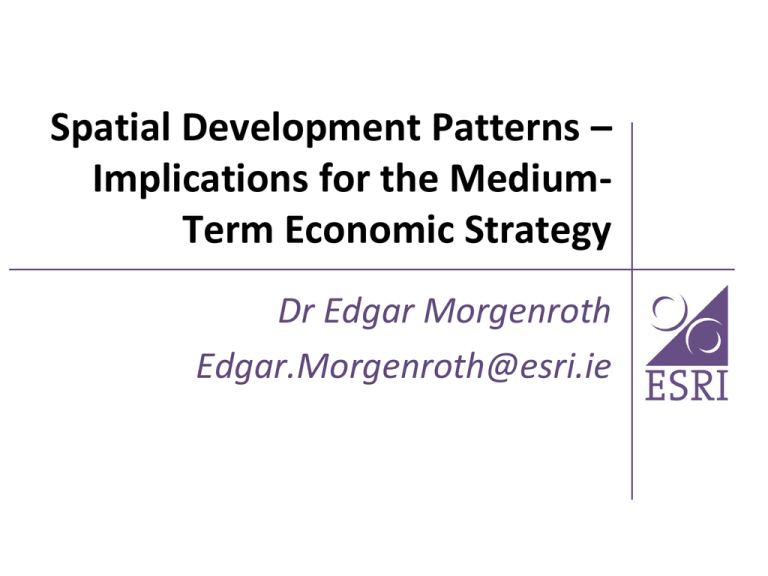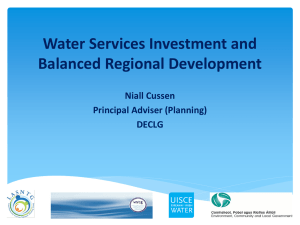Spatial Development Patterns * Implications for the Medium
advertisement

Spatial Development Patterns – Implications for the MediumTerm Economic Strategy Dr Edgar Morgenroth Edgar.Morgenroth@esri.ie Introduction Development is not evenly spread in any country - there is significant heterogeneity across Irish counties and regions. Spatial patterns have developed over a long period through the decisions of individuals, firms and government – the patterns are significantly shaped by market activity. An extensive research literature has shown that spatial patterns impact on macroeconomic performance. The objective of the paper is to identify the impact of these spatial patterns on overall economic performance. This is done with reference to the international and the more limited Irish literature. 2 Population and Job Densities, 2011 (Jobs scaled to the population) Job Density (No. per Sq.km) Population Density (No. per SQ. km) 1 - 10 11 - 50 51 - 150 151 - 1000 0 - 10 11 - 50 51 - 150 151 - 1000 1001 - 36909 1001 - 19575 3 Employment (location of Jobs) by County 2006 and 2011 Population Growth 1986-2011 ed_lcd 6% - 10% pd8691 11% - 15% -7% - 0% 1% - 5% 16%+ Index of Gross Value Added per Capita (100% =National Average) 6 Regional Share in the Recession (real GVA change as share of national) 7 Cavan Donegal Leitrim Louth Monaghan Sligo Laois Longford Offaly Westmeath Galway Mayo Roscommon Dublin Kildare Meath Wicklow Clare Limerick Tipperary NR Carlow Kilkenny Tipperary SR Waterford Wexford Cork Kerry Total Income per Capita, 1991, 2000 and 2010 (100% = National Average) 140% 120% 100% 80% 60% 1991 40% 2000 20% 2010 0% 8 What Drives Growth? Factor accumulation: - Population, - Private capital, - Public capital (infrastructure), - Human capital (education and skills), - Knowledge (R&D, innovation), - Social capital (institutions, laws, trust, leadership etc.). Factors that facilitate factor accumulation - Finance (needed to invest) Factors that increase the efficiency of production factors - Trade (scale and specialisation benefits) 9 Factors are not evenly distributed! What drives the location patterns? What are the macroeconomic implications? Maps (and graphs) cannot answer these questions – econometric analysis is required. 10 Firm Demography and Location Decisions Research on business start-up rates for Ireland including Irish counties found that fast growth in the 2001-2004 period did not lead to higher start up activity nationally but there was a degree of convergence across counties, particularly for counties close to Dublin (Anyadike-Danes et al, 2011). In 2011 49% of IDA supported jobs were located in the Dublin and Mid-East regions (population share is 39%) and this share has been steadily growing. Multinationals appear to have a positive impact on firm entry in manufacturing (Görg and Strobl, 2002) and the firm survival rate (Görg and Strobl, 2003), which suggests that these location patterns are reinforcing the overall spatial pattern of economic activity. 11 Firm Demography and Location Decisions New firm formation rates in the USA are higher in areas of higher industrial density (firms per capita) and faster population growth (Armington and Acs, 2002). There is a strong correlation between the location of venture capital firms and research-intensive biotech firms in the USA (Powell et al 2002). Headquarters cluster disproportionately in larger cities due to the availability of more differentiated business services in larger centres and also because of knowledge spillovers across headquarters (Davis and Henderson, 2008). 12 Density and Specialisation Areas with higher employment densities (cities) have higher productivity (e.g. Ciccone and Hall, 1996, Ciccone, 2002). This is due to the same type of production externalities that generate agglomeration economies e.g. shorter transport distance, increased supply and demand for skilled labour (competition). Firm selection is not a factor in explaining these productivity differences (Combes et al. 2012). Diversity leads to improved local supply linkages, which in turn leads to growth (Quigley, 1998). Regions with declining levels of specialisation tended to grow faster (Krieger-Boden, Morgenroth and Petrakos , 2008). 13 Impact of the Scale Urban Centres Doubling the size of a city increases productivity by between 3% and 8% (Rosenthal and Strange, 2004). Doubling industry scale increases productivity by 4.5% (Nakamura, 1985). Thus, the particular spatial configuration impacts on aggregate economic performance. Take a hypothetical country with one million workers equally distributed across two cities. The estimates by Rosenthal and Strange (2004) and Nakamura (1985) would suggest that if instead there were just one city, total productivity would rise by between 3% and 8%. 14 Rank-Size Relationship for Urban Centres in Selected European Countries Spatial Extent of Agglomeration Economies Agglomeration economies are subject to rapid spatial decay i.e. they are very localised. For example Graham (2009) found that such externalities are confined to a 10 kilometre radius. This implies that agglomeration economies, or critical mass (NSS), cannot be achieved by including the employment or population of a wide hinterland. It also means that simply aggregating a number of urban centres that are some distance apart, such as the Midlands gateway, will not generate the additional productivity due to increased scale. What really matters is the contiguously dense part of the agglomeration. 16 Innovation, R&D Knowledge spillovers are spatially restricted and thus create agglomeration economies (Audretsch, 1998) Industries in which knowledge spillovers are important have a greater propensity to cluster (Audretsch and Feldman, 1996). Informal contacts are an important source for knowledge spilover - the volume and range of such contacts is significantly greater in agglomerations (e.g. Dahl & Pedersen, 2004). Research intensive sectors tend to locate close to universities (Zucker et al, 1998). Innovation per capita has been found to be positively related to density of employment (Carlino, 2007). 17 Infrastructure Infrastructure promotes growth, but the context is important – existing stock, demand, cost. The cost of providing infrastructure also tends to be lower in agglomerations once this cost is measured on a per capita or per job basis (Büttner et al. 2004, Hortas Rico and Sole-Olle, 2010). Peripherality matters but cannot be eliminated!! An improved road (N2/A5) between Letterkenny and Dublin would reduce the travel time significantly. However, it would still take much longer to get to Dublin than it does from most other places. A focus on links to Belfast would help more than links to Dublin!! 18 Real Per Capita Public Capital Expenditure by Region 19 Population & Urban Hierarchy Many countries have an urban hierarchy characterised by a rank-size rule such that the second largest city is roughly half the size of the largest city, and the third largest city is roughly half the size of the second largest city (Garbaix, 1999). However, in Ireland the scale of urban centres declines faster than in most other countries, i.e. the second, third, fourth... cities are smaller than one would expect. A more typical urban structure would imply that Cork would have a population of 550,000 rather than just under 200,000. 20 Skilled Labour Force High skills individuals agglomerate in the larger, denser and more skilled labour markets (Combes et al., 2008). It is also easier to get a job that is commensurate with the level of qualification in larger centres, particularly for two earner families where both earners have a university degree (Costa and Kahn, 2000). High skills individuals choose their residential location on the basis of quality of life characteristics (Glaeser et al., 2001). 21 Number of persons with a Doctorate, 2006 PHDs 2006 6-8 0 9 - 12 1 13 - 19 2 20 - 33 3 34 - 150 4-5 Number of persons with a Doctorate, 2011 PHDs 2011 6-8 0 9 - 12 1 13 - 19 2 20 - 33 3 34 - 245 4-5 Policy Implications (1) Agglomeration forces are strong and efficiency enhancing up to a point where areas are excessively congested. Policies to counteract these forces should therefore be avoided as they are likely to be ineffective and damaging to national welfare. Efficiency enhancing agglomerations also imply that regional balance i.e. equal levels of economic activity and population is not going to be achieved. Rather, the focus of policy should be to ensure that the resources of all regions are fully utilised. The size distribution of urban centres in Ireland is characterised by relatively small second tier centres. It would be particularly desirable to increase the scale of these centres as this will have significant productivity benefits. 24 Policy Implications (2) Scale in second tier urban centres cannot be created by a mere redrawing of boundaries or by pairing up towns that are some distance apart. What matters is the size of the contiguously dense area. This also implies that policy should aim at increasing this contiguous density. Infrastructure investment should support the development of the second-tier centres, but should also ensure that diseconomies do not arise in Dublin and that other areas are able to benefit from spillovers from the larger centres. Infrastructure development in relatively sparsely populated areas is unlikely to have significant returns unless it is directly linked to economic development through local resources. 25 Policy Implications (3) Policy instruments to reduce sprawl are needed. However, given the locational preferences of individuals, policies to reduce the disamenities of density, for example measures to make dense areas more family friendly, need to be found. While development is likely to centre on agglomerations, linking these with their rural hinterland will be important to ensure that the benefits of agglomeration are spread more widely. Such linkages should however avoid additional sprawl. A focus on a single development factor tends to be misguided as underdevelopment tends to be due to multiple interrelated factors. In particular remoteness is difficult to overcome even with additional transport infrastructure. Thus, more remote regions will need to focus on other factors and 26 try to build on their strengths such as quality of life. Policy Implications (4) Social capital broadly defined is an important factor in mobilising resources at a local level and is a key factor in successful regions. However, this is often lacking in less developed areas. A limited competitive fund that contributes to innovative actions could incentivise local leadership and closer co-operation across stakeholders. Development plans should pay more attention to the drivers of economic development. As spatial patterns change only slowly, development plans should be realistic about what is achievable. In order to achieve proper co-ordination, the conformity of local and regional development plans to the national spatial strategy should be approved centrally. 27 Policy Implications (5) Remote areas have been suffering persistent population decline. This trend is unlikely to be reversed, given the underlying drivers of development. This implies that spatial development plans need to also take account of and plan for depopulation. Policy should primarily address the negative spatial externalities. As these are typically local, it is at the local scale that these are more effectively addressed. Nevertheless, regional development issues, and the effect of national policies on these issues should be considered across all levels of government. 28 Other Issues A lot of the relevant literature is concerned with other countries and particularly the USA. What are the effects in Ireland e.g. what is the elasticity of productivity with respect to density in Ireland? What are the wider costs of the dispersed settlement pattern in Ireland (transport, infrastructure, flood defences etc.)? The Local Government Reform Bill, 2013 requires that the Regional Assemblies prepare Regional Spatial and Economic Strategies – what are these to be based on? Up now national (NSS) regional (RPGs) and local plans have not been based on rigorous economic analysis. 29 Thank You! 30




